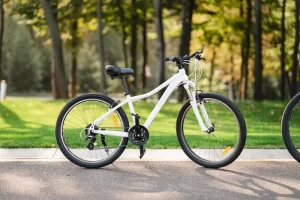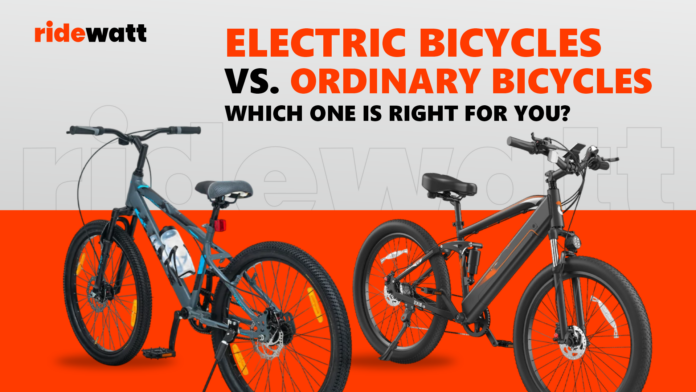In recent years, the debate between electric and ordinary bicycles has gained momentum as more people are looking for eco-friendly, cost-effective, and healthy modes of transportation for their day-to-day lives. Both options offer unique advantages and disadvantages depending on your needs, lifestyle, and goals. So are you curious to know about each type’s costs, maintenance requirements, terrain suitability, and fitness benefits? Let’s dive into the details and uncover which two-wheeled companion might be best for you. First, let’s learn about electric and traditional bicycles. Then we will explore more about this together.
What Are Electric Bicycles?
Electric bicycles (e-bikes) are equipped with an electric motor that assists with pedalling, making them easier to ride. Powered by rechargeable batteries, e-bikes enable riders to travel longer distances with less physical effort. They come in various designs, ranging from models that resemble traditional bicycles with compact motors to larger, more powerful versions similar to mopeds.
What Are Ordinary Bicycles?

Ordinary bicycles, also known as traditional or regular bicycles, are powered entirely by human effort, relying on the rider’s pedalling for movement. These bikes come in a variety of types—road bikes, mountain bikes, hybrid bikes, fat-tire bikes, and more—each designed for specific terrains and purposes. Known for their simplicity and the physical effort they demand, while traditional bicycles provide a more hands-on, active riding experience. Curious to explore the different types of bicycles? Check out Beginner’s Guide to Buying Your First Bike.
Electric vs. Ordinary Bicycles: 5 Essential Comparisons You Need to Know
Cost Comparison: Initial Investment and Long-Term Expenses
- Electric Bicycles: The initial cost of an electric bicycle is significantly higher than an ordinary bicycle. Prices for e-bikes typically range from 30,000 or more, depending on features like motor power, battery capacity, and additional tech. Beyond the upfront cost, maintenance expenses for components like the battery and motor add to the long-term financial commitment.
- Ordinary Bicycles: Traditional bicycles are far more budget-friendly, with entry-level models starting as low as 4,000 to 6,000 rupees Maintenance costs are minimal and involve regular tune-ups, tyre replacements, and chain lubrication, making ordinary bicycles an economical choice for most riders.
Maintenance: Keeping Your Ride in Top Shape
- Electric Bicycles: Maintaining an e-bike in top shape is more complex than traditional bikes due to their electronic components. E-bike batteries require regular charging and eventual replacement, which can be costly. Additionally, the issues with the motor or controller often necessitate needing professional repairs, adding to maintenance challenges.
- Ordinary Bicycles: Maintaining an ordinary bicycle is straightforward, simple, and often DIY-friendly. With fewer mechanical components, you’re less likely to encounter major breakdowns. Routine tasks like brake adjustments and tyre replacements can be done at home with basic tools.
Exercise Value: Boosting Physical Fitness
- Electric Bicycles: While e-bikes assist with pedalling, they still require effort, especially in low-assistance modes. Studies have shown that e-bike riders often cycle longer distances than traditional cyclists, contributing to cardiovascular health and endurance. However, the assistance may reduce the intensity of the workout compared to ordinary bicycles.
- Ordinary Bicycles: Traditional bicycles are unparalleled when it comes to exercise. With no motor assistance, every pedal stroke engages your muscles, strengthens your heart, and burns calories. If fitness and weight management are your primary goals, an ordinary bicycle is a more effective tool for achieving them.
Environmental Impact: Sustainable Choices
Both electric and ordinary bicycles are environmentally friendly alternatives to motor vehicles, reducing carbon emissions and traffic congestion. However, e-bikes have a slight environmental footprint due to their battery production and eventual disposal. Traditional bicycles, with no electronic components, are the most sustainable option.
Choosing the Right Bicycle for Your Needs
Opt for an electric bicycle if:
- You frequently commute over long distances or hilly terrain.
- You need assistance due to health conditions or physical limitations.
- You want a versatile option for mixed-terrain riding.
Opt for an ordinary bicycle if:
- You prioritise fitness and physical activity.
- You are searching for a low-maintenance, reasonably priced solution.
- You’re navigating flat terrain or using it for leisure.
Final Thoughts: Finding the Perfect Balance
Deciding between which one you want—an electric bicycle or an ordinary bicycle—ultimately depends on your personal preferences, goals, and lifestyle. If convenience and versatility are your top priorities, you can go for the electric bicycle, as an e-bike offers a seamless and enjoyable riding experience. On the other hand, if your pocket is a little tight or you want to do an excessive muscle workout, you can go for the ordinary bicycle. As it offers cost-effectiveness and a robust workout, a traditional bicycle delivers unmatched value.
Both types of bicycles bring immense benefits to the table, from improving cardiovascular health to reducing your environmental footprint. Regardless of your choice, cycling remains one of the most rewarding and sustainable activities you can incorporate into your life. So, take a test ride, weigh the pros and cons, and choose the ride that fits you and your budget best.
Happy Cycling! & Keep Pedalling!
Also, check out https://ridewatt.com/5-reasons-you-should-have-an-e-bike-in-your-garage/


































